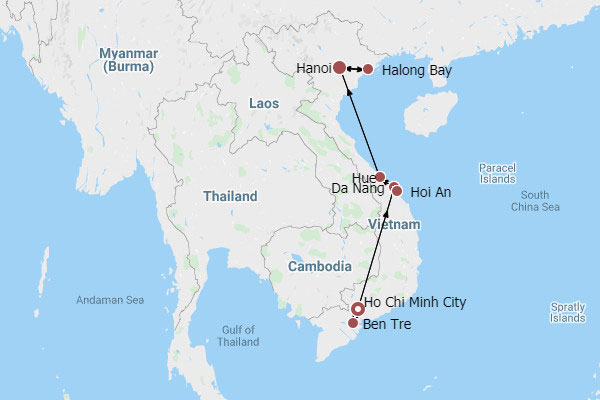Embark on an enlightening journey as we delve into the geographic distance between two pivotal cities in Vietnam: Ho Chi Minh City and Hanoi. Understanding the expanse that separates these vibrant metropolises holds significance for travelers, logisticians, and those seeking insights into the rich tapestry of Vietnam’s landscape. Whether for business, leisure, or sheer curiosity, uncovering the distance between these two urban gems can empower you with essential knowledge for planning seamless travel and appreciating the vastness of this captivating nation.

Image: www.travelchinaguide.com
Geographic Proximity: A Measure of Separation
The distance between Ho Chi Minh City, also known as Saigon, and Hanoi, the capital of Vietnam, extends approximately 1,600 kilometers (994 miles). This substantial gap translates to a journey spanning roughly 1,150 miles by road. The significant separation between these urban hubs underscores the geographical diversity and expansive nature of Vietnam’s terrain.
Historical Context: Shaping the Landscape
Throughout history, the distance between Ho Chi Minh City and Hanoi has played a pivotal role in shaping the political, economic, and cultural dynamics of Vietnam. During the era of French colonial rule, Hanoi served as the administrative capital, while Ho Chi Minh City flourished as the country’s commercial hub. This spatial separation between the political and economic centers fostered distinct identities and perspectives within these cities.
Post-independence, the distance between Hanoi and Ho Chi Minh City continued to influence the nation’s development. The reunification of Vietnam in 1976 marked a significant chapter, yet the physical distance between the two cities necessitated careful planning and infrastructure development to ensure effective governance and economic integration.
Modern-Day Connectivity: Bridging the Gap
In contemporary times, the distance between Ho Chi Minh City and Hanoi has become less of an obstacle and more of an opportunity for collaboration and exchange. The expansion of transportation networks, including highways, railways, and air routes, has significantly reduced travel time and enhanced connectivity between these two major cities.
The advent of high-speed rail lines, such as the North-South Railway, has further shortened travel times, enabling day trips and frequent commuting between the cities. This improved infrastructure has not only facilitated business and trade but has also fostered cultural exchange and tourism.

Image: www.tourradar.com
Planning Your Journey: Considerations and Tips
Planning a journey between Ho Chi Minh City and Hanoi requires careful consideration of distance, travel options, and personal preferences. Air travel remains the quickest and most convenient mode of transportation, offering multiple daily flights and taking approximately two hours. For those seeking a more immersive experience, train travel provides an opportunity to witness Vietnam’s diverse landscapes and interact with locals. Train journeys typically range from 30 to 36 hours, offering both day and overnight options.
Road travel, while the longest in terms of duration, presents a unique opportunity to explore the country’s countryside and hidden gems. This option is best suited for those with ample time and a desire for spontaneity. Private vehicles and organized bus tours are available for road travel, with the journey taking approximately 30 to 36 hours.
How Far Is Saigon To Hanoi
Conclusion: Connecting the Dots
The distance between Ho Chi Minh City and Hanoi represents more than a mere geographical separation; it is a testament to Vietnam’s rich history, diverse landscapes, and the transformative power of connectivity. Whether you choose to traverse this distance by air, rail, or road, the journey promises a tapestry of experiences and a deeper appreciation for the tapestry of Vietnamese life. Embrace the distance as a gateway to exploration, discovery, and the enduring spirit of a nation.